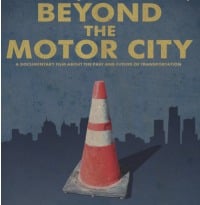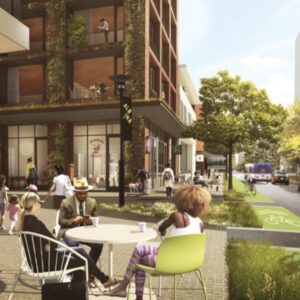
On Tuesday (6/29), the Architects Without Borders and the Oregon Transportation Research and Education Consortium will host a free screening of PBS’s Beyond the Motor City.
The film is part of the PBS special series, Blueprint America, which takes an in-depth look at the past, present and future state of our country’s transportation infrastructure (one of the segments prominently features Portland).
According to PBS, Beyond Motor City “examines how Detroit, a symbol of America’s diminishing status in the world, may come to represent the future of transportation and progress in America.”
After the screening, the director of the film, Aaron Woolf (who also did the documentary King Corn) will join a panel with local transportation and planning experts Gil Kelley (former Planning Director for City of Portland, now a consultant) and Bob Hastings (an architect and designer for TriMet). Ethan Seltzer, an urban planning professor from Portland State University will moderate.
The panel will ask “whether Portland’s transportation system offers an exit from economic decline or a fast track to ruin. Is Detroit where Portland is coming from or where it’s going?” It will be interesting to see what type of role these experts feel the bicycle will play a role in our transportation future.
The screening is at 6:30pm on June 29th at McMenamins Bagdad Theater (3702 SE Hawthorne Blvd.). More event details here.
Watch the trailer below…







Thanks for reading.
BikePortland has served this community with independent community journalism since 2005. We rely on subscriptions from readers like you to survive. Your financial support is vital in keeping this valuable resource alive and well.
Please subscribe today to strengthen and expand our work.
Does anyone know what bike parking near the Bagdad is like?
there are staples and signposts here and there, and a shelter with about four small staples at the corner of 38th.
Detroit is finally realizing that the only way to return to greatness is to do what Portland did.
FYI, the embedded video is not the trailer.
Thanks Hart. Should be the right one now. — Jonathan
Hart (#3) – Detroit isn’t realizing anything of the sort, they’re blazing their own path, and Portland would do well to pay close attention to what’s working and what isn’t. Detroit had its neighborhoods destroyed in the 50s and 60s, lost a third of its structures to the wrecking ball, and saw the largest demographic shift of any metropolitan area over the last 40 years. They’ve made their own mistakes and had their own triumphs, largely without federal or local funding.
Also, Detroit will never “return to greatness” – it has half the population it had 50 years ago, and hasn’t been a world-class city since the 1980s. It is carving out a new identity, and a new niche. They seem to have learned they can have their own identity rather than trying to relive the glory days.
Having a lower population IS returning to greatness.
For those into a wonky discussion of Detroit and city brands, this piece by The Urbanophile is really thought provoking: http://www.urbanophile.com/2010/05/13/the-authentic-city/
@are #2 Thank you! I did go looking online, and my researches were inconclusive.
They resulted, however, in a note to Sarah Figliozzi of PBOT’s bike parking program, and an almost instantaneous improvement to their webpage–she changed the listing of bike corrals from chronological by install date to a useful grouping by area of town.
Yay Sarah!
Detroit could be a fascinating study in how to rebuild a city. I have read about great ideas to bulldoze entire abandoned neighborhoods to use the land for farming and to create “rings” around the downtown core alternating housing/commercial development with agricultural/greenspaces. Plus, the city is nearly pancake flat and just about perfect for reworking thoroughfares exclusively as bikeways.
If they do it right, Detrit could become America’s Copenhagen and Portland would have much catching up to do.
Hart (#6) – True, perhaps I shouldn’t jump to conclusions about your definition of greatness. 🙂
Brad (#9) – I doubt Detroit will become another Copenhagen, because the political will isn’t there, and the auto industry still holds too much sway. I have no hope for Detroit’s suburbs, which are bereft of anything resembling a soul. The rural areas are nice, but not exactly diverse. I think Detroit will become… Detroit. It will reinvent itself and redesign itself from the inside out and the ground up with citizen’s initiatives and people doing what works, and like Copenhagen will eventually become the city that others are compared to. It won’t be another Copenhagen, it’ll be Detroit – and other cities will aspire to do what they did.
But it will be born in pain, as it has been for the past 40 years.
I saw this movie at a screening here in Minneapolis. Go see it. It’s a phenomenal, well-done movie that manages to touch on the many inter-linking urban issues that relate to transportation and urban investment.
I think Detroit’s suburbs have vastly more soul than gresham and beaverton. And Grosse Point ______ is made nicer and build to last unlike our dime a dozen over priced bungalows. Detroit needs to reinvent itself, but its in a tough spot, but it has little to lose. They can gamble.
I am really looking forward to this.
That is all.
Grimm (#12) – Some may, but Sterling Heights, Livonia, Troy, Novi and Taylor for example do not, and combined they represent well over a quarter million people. Warren and Rochester Hills aren’t any better, nor is Redford, Dearborn, or Auburn Hills. (combined we’re now up to 750,000 or so) All of those suburbs have miles of strip malls, each has at least one major shopping mall, and at least one 6-8 lane highway. Gresham and Beaverton have bike lanes, a real transit system, and mostly intact neighborhoods that are not dissected by freeways.
Grosse Pointe is Detroit’s equivalent of Lake Oswego – it’s nice, but not exactly affordable. But it raises a good point – the surburbs immediately adjacent to Detroit have more community than those in the great suburban bathtub ring.
I lived in metro Detroit for 22 years. If I moved back there, I could live in Detroit proper, or Hamtramck, or Ferndale, or Royal Oak – but you couldn’t pay me to live north of 10 Mile Road, or west of Telegraph, unless I was moving to somewhere like Armada or Leonard, or Dexter – far enough out to escape the things that caused me to leave in the first place. Portland has spoiled me, and the two weeks I spent in Utica earlier this year nearly killed me.
Long Live Hizzoner, Mayor Coleman Young!
If you have never lived or spent an extended amount of time in Detroit and it’s surrounding suburbs, you have NO idea what it is like there, and anyone who has never been there cannot comment about the city and be taken seriously in any way.
Go to You Tube, search Detroit Ghetto and enjoy the videos. You will be astounded as to the ruins and wasteland. Imagine 1/3 of the houses on your block gone or half burnt down. That is what to expect.
Coleman was like Nixon, except he never got caught: controversial, hated by many, sneaky as hell, involved in shady dealings, yet got a lot accomplished, much of it good.
That said, Coleman A. Young arguably damaged the city in many ways – though much of that may have beenmore a factor of the demographic shifts and the freeway system than the mayor’s actions and policies.
Between Coleman Young and Bill Bonds, Detroiters were never bored.
I saw this film last night. It was interesting and I question the following:
Removing the previous street car infrastructure was not simply due to “the rise of the private automobile” as stated in the film, it was a deliberate buy-out by the auto industry to dominate regional transportation.
Also, the film left me with the sense that it was a big high speed rail commercial which runs counter to the producer’s comments post-screening about big expensive solutions being more sexy than more effective 10 cent solutions. Why was there not a single mention of bicycles as part of the transportation network? Detroit is certainly climatically challenged but no more so than Minnesota, Wisconsin or Quebec. All that asphalt, fairly flat topography and less expensive infrastructure makes bicycles a viable part of a transit network and offers citizens independence.
I wonder how Spain feels now, 1yr after filming, about its investment in rail given recent austerity measures. I suspect they are even more pleased that they committed when they did.